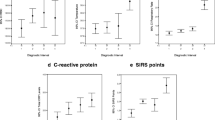Abstract
Introduction. Chronic appendicitis is not generally accepted as an independent clinical entity. The diagnosis is often made only after histological analysis when the patient has undergone appendectomy in a case of persistent or recurrent pain. The objectives of this prospective study were to analyse the incidence of chronic appendicitis among our patients, to compare demographic and clinical data with histological results and to evaluate long-term follow-up after appendectomy.
Methods. Between November 1995 and February 1998, 322 patients underwent appendectomy due to typical symptoms of appendicitis. All appendices were analysed macroscopically by the surgeon and histologically by two independent pathologists. Furthermore, demographic data, standard blood results, Alvarado score, body mass index, operation time, complications, and length of hospital stay were evaluated. In April 2001, a long-term follow-up survey evaluated the present complaints of all operated patients.
Results. A total of 112 patients showed clinical signs of non-acute appendicitis. However, 26.8% of these appendices histologically revealed an acute inflammation. In the subgroup of histologically non-acute appendicitis, 4.9% of the appendices were inconspicuous, 42.0% chronically inflamed and 50.6% fibrotic. Compared to that, the macroscopic examination by the surgeon resulted in a 93.5% specificity and a 77.8% sensitivity. The preoperative period of pain was significantly longer (7 days) compared to patients with acute appendicitis (0.5 days). White blood count (8.700 versus 13.400) and preoperative Alvarado score (4 versus 7 points) were significantly lower, the hospital stay significantly shorter (3 versus 4 days). A specificity of 89.9% and a positive likelihood ratio of 4.64 were calculated for an optimal cut-off value of 7 days for preoperative pain. At a median of 50.2 months after the operation, 93.1% of the patients were asymptomatic, and five patients reported persistent pain in the right lower quadrant.
Conclusions. Three quarter of all patients with pain in the right lower quadrant but no significant signs of inflammation showed the histological criteria for chronic appendicitis. However, histology revealed signs of an acute inflammation in 25% of patients. An optimal cut-off value of 7 days preoperative period of pain was able to suggest a histologically non-acute appendicitis with a high specificity and a high positive predictive value. More than 93% of these patients were asymptomatic in their long-term follow-up. Chronic appendicitis must be assumed in cases of recurrent or persistent pain longer than 7 days and an elective appendectomy has to be recommended.
Zusammenfassung
Einleitung. Als eigenständige Entität ist die chronische Appendizitis klinisch bislang nicht gänzlich akzeptiert. Die Diagnose wird oft erst nach Vorliegen des histologischen Ergebnisses gestellt, wenn bei Beschwerdepersistenz oder bei rezidivierenden Schmerzen die Appendektomie erfolgt. Ziele dieser Studie waren daher, die Inzidenz an einem prospektiv erhobenen Patientenkollektiv zu erfassen, demographische und klinische Daten mit dem histologischen Befund zu korrelieren und den Langzeitverlauf nach Appendektomie zu beschreiben.
Methoden. Zwischen November 1995 und Februar 1998 wurden insgesamt 322 Patienten bei typischen Schmerzen im rechten Unterbauch appendektomiert. Die Appendizes wurden sowohl intraoperativ makroskopisch vom Operateur als auch postoperativ von 2 unabhängigen, erfahrenen Pathologen histologisch beurteilt. Neben den demographischen Daten wurden die laborchemischen Parameter, Alvarado-Score, Body-Mass-Index, Operationszeit, Komplikationen und Dauer des stationären Aufenthalts erfasst. Zur Langzeitbeurteilung wurden die appendektomierten Patienten im April 2001 nochmals zu den aktuellen Beschwerden befragt.
Ergebnisse. Die klinischen Zeichen einer nicht-akuten Appendizitis zeigten 112 Patienten. Histologisch waren 26,8% dieser Appendizes dennoch akut entzündet. In der Gruppe der histologisch nicht-akuten Appendizitiden waren 4,9% unauffällig, 42,0% chronisch entzündet und 50,6% fibrosiert. Die makroskopische Beurteilung durch den Operateur zeigte im Vergleich eine Spezifität von 93,5% und eine Sensitivität von 77,8%. Dabei war die präoperative Schmerzdauer in diesem Kollektiv hochsignifikant länger (7 Tage) als bei Patienten mit akuter Appendizitis (0,5 Tage). Die Leukozytenzahlen (8.700 vs. 13.400) waren wie der präoperative Alvarado-Score (4 vs. 7 Punkte) hochsignifikant niedriger, der stationäre Aufenthalt signifikant kürzer (3 vs. 4 Tage). Für einen optimalen Cut-off-Wert von 7 Tagen präoperativer Schmerzdauer wurde eine Spezifität von 89,9% und ein positives Wahrscheinlichkeitsverhältnis von 4,64 errechnet. Im Median von 50,2 Monaten postoperativ waren 93,1% der Patienten subjektiv beschwerdefrei, 5 Patienten berichteten weiterhin über Schmerzen im rechten Unterbauch.
Schlussfolgerung. Etwa 3/4 aller Patienten mit klinisch nicht-akuten Schmerzen im rechten Unterbauch wiesen histologisch die Kriterien einer chronischen Entzündung auf, 1/4 allerdings auch Zeichen einer akuten Inflammation. Ein optimaler Cut-off-Wert von 7 Tagen präklinischer Schmerzdauer konnte mit hoher Spezifität und hohem positivem prädiktiven Wert eine histologisch nicht-akute Appendizitis diagnostizieren. Im Langzeitverlauf waren über 93% dieser Patienten subjektiv beschwerdefrei. Bei rezidivierenden oder über 7 Tage persistierenden Schmerzen im rechten Unterbauch sollte von einer chronischen Appendizitis ausgegangen und die elektive Appendektomie empfohlen werden.
Similar content being viewed by others
Author information
Authors and Affiliations
Rights and permissions
About this article
Cite this article
Mussack, T., Schmidbauer, S., Nerlich, A. et al. Die chronische Appendizitis als eigenständige klinische Entität. Chirurg 73, 710–715 (2002). https://doi.org/10.1007/s00104-002-0437-1
Published:
Issue Date:
DOI: https://doi.org/10.1007/s00104-002-0437-1




